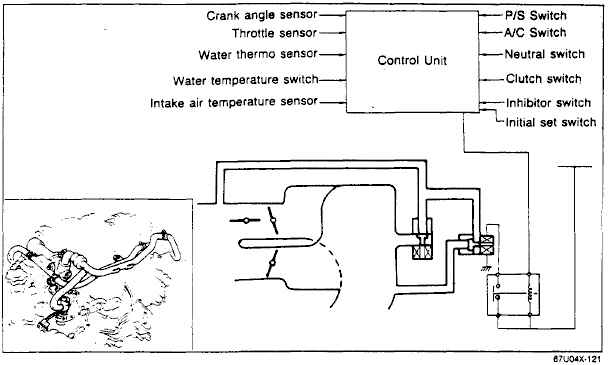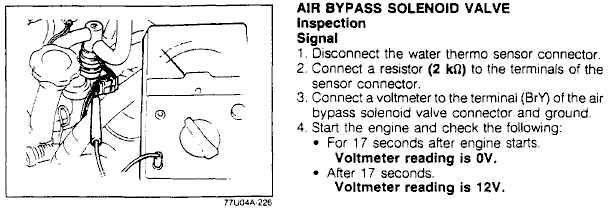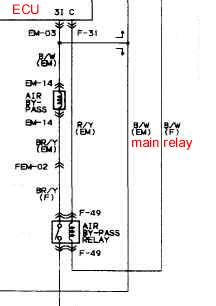IDLE CONTROL SYSTEM
The idle control system is also referred to as the bypass air control (BAC) system. Idle is controlled mainly by the bypass air control (BAC) valve. What is meant by idle control is that the ECU tries to maintain the idle speed that was set as the base idle speed by allowing more bypassed air (in addition to the air already bypassed by the base idle circuit) when needed. There is also an air bypass solenoid valve which plays a role only upon start-up. This below shows the schematics of the idle control system. The BAC valve is the left-most of the two valves.

BAC VALVE
The BAC valve is part of an air feed line that directs air taken before the throttle plates (in the the air funnel) to the intake manifold after the throttle plates. This air "bypasses" the normal path of air to the intake manifold which is via the throttle bores. The BAC valve is a vibrating valve which opens and closes at a given frequency by being fed a pulse signal by the engine control unit (ECU). The ECU controls how much the BAC valve is actually opened by varying the pulse width. The longer the pulse width, the longer the BAC valve is opened. The ECU controls the BAC valve based upon inputs that affect idle. These inputs are:
- crank angle sensor (tells the ECU the engine's speed)
- throttle position sensor (tells the ECU the throttle plate angle: a fully closed position puts the ECU in idle mode)
- water thermo sensor (tells the ECU the engine coolant temperature)
- water temperature switch (tells the ECU the temperature of the air near the radiator)
- intake air temperature sensor (tells the ECU the temperature of the air entering the intake)
- power steering (P/S) switch (tells the ECU the driver is turning the wheels)
- air conditioning (A/C) switch (tells the ECU the A/C compressor is engaged)
- neutral switch (tells the ECU the transmission is in neutral)
- clutch switch (tells the ECU the clutch pedal is depressed)
- inhibitor switch (only an automatic transmission, not discussed here)
- initial set switch (for setting idle speed, not discussed here)
The basics behind the BAC valve is that it should allow more air into the engine when the engine load increases. An increase in engine load is sensed by the ECU when the crank angle sensor (CAS) indicates a decrease in engine speed. As an example, when the headlights are turned on, the alternator has to produce more current. It is therefore putting more load on the engine and slowing it down. To prevent the engine from turning too slow (or even stalling), the ECU compensates the increased load by lengthening the pulse width to the BAC valve. This has the effect of increasing the engine speed back to normal idle speed (obtained when there is no load on engine). For some load types, the ECU does not rely on the CAS to detect load increase but on some special switches: P/S, A/C, neutral, and clutch switches.
Please be well aware that the base idle speed does not come from the BAC valve itself, but from some "plumbing" within the intake. The base idle speed (750 rpm) can be adjusted by turning the capped screw on top of the intake. It has nothing to do with the BAC valve, and this is why you should always adjust the base idle speed by setting the initial set coupler or disconnecting the BAC connector (at the BAC valve).
The BAC valve connects to the main relay through a B/W (black with white stripe) wire and to pin 2Q of the ECU through a L/G (blue with green stripe) wire. The main relay has a 12V DC voltage when the engine is running. Pin 2Q is a pulse (square) signal at a fixed frequency provided by the ECU. The BAC valve is closed when the voltage at pin 2Q is 12V and open when the voltage is 0V (grounded). This means that the longer the valve stays open, the lower the DC voltage at pin 2Q is. The DC voltage that is measured at pin 2Q is the average of the actual pulse voltage. To sum it up, the lower the DC voltage at pin 2Q is, the longer the pulse width (0V pulse) is and the longer the valve stays open (the more air passes through the BAC valve). As an example, the DC voltage at pin 2Q will drop if the headlights are turned on (maybe from 11.5V to 11V). If the defroster is also turned on, it will drop even further (maybe, from 11V to 10.5V).
AIR BYPASS SOLENOID VALVE
This valve bypasses air to the intake when a "cold" engine is started up. It is a solenoid valve, meaning it is open when energized (it is not a vibrating valve like the BAC valve).


This above is the factory service manual (FSM) check for proper operation of the air bypass solenoid valve and the circuit diagram for the valve and its relay. The air bypass solenoid valve is open when 12V is applied between its terminals. One of the two terminal connects to the main relay via a B/W (black with white stripe) wire. The other terminal connects to the air bypass relay via a Br/Y (brown with yellow stripe) wire. Since the B/W wire sees 12V when engine running, the Br/Y wire must be at 0V (grounded) to energize and therefore open the valve. When a cold engine is started, the air bypass solenoid valve is energized for 17 seconds to allow for extra bypassed air. This is an accelerated warmup system. The air bypass relay is here to ground the Br/Y wire when the ECU energizes its coil side (0V at pin 1C).
Copyright © 2003 - The MAZDA RX-7 86-88 Technical Page - All Rights Reserved